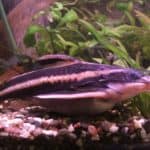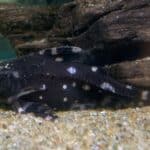Walking Catfish are known for their greedy nature and they put on weight very quickly, making them a popular choice to be bred for food consumption.
They are also popular with aquarists as they are cheap and are usually sold at juvenile age when they have a small, cute appearance. But they grow quickly and can be a real handful!

If you are interested in housing Walking Catfish in your home aquarium, or you want to find out more about the species, then keep reading. We have put together lots of interesting and useful information about their behaviour, diet, appearance, tank requirements and more.
Species Summary
Walking Catfish are native to South-East Asia, in countries like Sri Lanka, India, Pakistan, Burma, Singapore. Some Walking Catfish were released into North America in the 1960s and they have become a nuisance invasive species. They have a reputation for being destructive, mindless eating machines.
They live in rivers, swamps, canals, ditches, pools, rice paddies, and even stagnant water remaining after a river has flooded.
They ‘walk’ around by using their pectoral fins to ground themselves as they wriggle along the bottom of the tank or river. They can survive for approximately 30 hours outside of water due to their ability to breathe atmospheric air, so if they escape from a tank or pond they can cover quite some distance.
Their ability to wander does depend on the weather, as they have to stay damp in order to draw oxygen from the air. If it’s raining, they can enjoy nice long walks outside of the water. In the wild, they sometimes spend the night in damp mud rather than under water.
Care Guide
Tank Size
Walking Catfish need a lot of space to walk around and they grow to large sizes. 500 gallon tank. Width is more important than depth, so the tank can be fairly shallow as long as it has a tight lid to stop them escaping.
Tank Mates
Walking Catfish can only be housed with tankmates of a similar size or larger as they will try to eat anything smaller than them. You could try a robust fish like barbs and cichlids, but Walking Catfish are not generally suitable for a large community tank. They are very active so avoid any tank mates that could be stressed by their constant movement.
Same Species Tanks
If the tank is big enough then Walking Catfish can live in a small community of the same species as long as they are all the same size. Any smaller Catfish will get attacked.
Water Parameters
Walking Catfish can thrive in a relatively wide range of water parameters compared to other freshwater fish. They can also survive in stagnant water with very little oxygen, as they are able to leave the water and breathe in air.
However, to keep your fish as healthy as possible we recommended a water temperature of 68 to 78 degrees fahrenheit. The PH level should be between 5.5 to 8.0 and the water hardness can be anywhere from 2 to 25 KH.
What To Put In Their Tank
Choose a soft substrate like fine sand as Walking Catfish spend a lot of time wriggling across the bottom of the tank. Decorate the tank with smooth rocks and driftwood to provide hiding places for them.
You can even use plastic piping as long as you have carefully measured the diameter to ensure the fish won’t get stuck. Plant life is not essential, but they would prefer a slow water flow so make sure the pump isn’t too strong.
Common Diseases
In the wild, these fish carry many parasites due to the slow moving and sometimes stagnant water they live in, and the fact that they eat dead fish and insects. Make sure you are buying commercially raised Walking Catfish to avoid introducing parasites into your aquarium.
In a domestic tank, they can be prone to skin infections, so be sure to keep the tank clean and well maintained.
Food & Diet
Walking Catfish are omnivorous and will eat almost everything you give them. They don’t know when to stop eating so don’t feed them every day.
In the wild, Walking Catfish eat a lot of insects and fish- dead or alive- but realistically they will eat whatever is in front of them that will fit in their mouths.
To give them a nutritious diet, feed them with dried pellets, frozen shrimp and bloodworms, and supplement this with some leafy vegetables.
Lifespan
If the tank conditions are ideal and well maintained, these robust fish can live up to 15 years in captivity. Their lifespan in the wild is not known.
Appearance
Walking Catfish have an elongated body which is usually brown or gray in color, with small white spots. They have a fairly narrow head, with long anal and dorsal fins and whiskers protruding from their mouth.
You can get an albino variety of Walking Catfish which are white in color.
Juvenile Walking Catfish tend to be more colorful, with their vibrancy dulling over time.
These fish have a hidden sting, or venomous barb, behind its fins which they can release when being handled.
Size
Walking Catfish can grow over 3 feet long in the wild. The average length of an adult in captivity is around 18 to 24 inches.
They have a cute and endearing appearance as juveniles. This, combined with their low price tag, makes them a popular purchase from pet shops. But don’t be fooled- they will grow very big very quickly!
Behaviour & Temperament
Walking Catfish are greedy predatory fish with a destructive nature. They spend nearly all of their time moving around the tank searching for food which makes them one of the most active species for a home aquarium.
As they are bottom-dwellers they will spend most of their time on the bottom level, but have been known to ‘walk’ up the sides of the tank.
These fish are not very intelligent and will pick fights with other fish out of stupidity rather than courage, often winning because they never back down.
Breeding
Walking Catfish are bred commercially on fish farms, but breeding them in a domestic tank is not as easy. Once they form a bonded, sexually mature pair they will become extremely territorial and show aggression to their tank mates. They will need to be placed in a separate tank.
Just before the female is ready to lay her eggs, the pair will display increased body contact and closeness with each other, swimming side by side. In the wild, the fish like to lay their eggs inside caves dug into the bank of the river.
In a domestic tank they will likely try and dig some kind of nest in the substrate layer of the tank. The laying and fertilizing of the eggs takes around 20 hours, as the female will keep returning to the nest to lay more and each time the male will go behind her and fertilize them. The eggs are heavy and will sink straight away.
Once this process is complete, the male will guard the eggs for 24 to 36 hours until they have hatched, swimming constantly to patrol the area. When the eggs hatch, the male will remain directly over the nest and the female will patrol the perimeter of their territory.
They will keep watch for another 48 hours. After this point they will leave the smallfry to fend for themselves. Within 72 hours of hatching, the smallfry are able to swim independently.
At this point, they need to be separated from the parents to prevent them from being eaten. They can be fed with brine shrimp initially, but will grow very quickly and will soon be able to eat larger food.
Gender Differences: Male vs Female
You can differentiate between the sexes in the wild as the male will develop a spotted pattern on the dorsal fin, but they do not do this in captivity. The only way to sex them in a domestic tank is to compare their gentitalia.
Males have long and pointy papillae whereas females have short, blunted papilla. The body shape will also give you some indication as females have a more rounded belly.
Fun Facts
- Walking Catfish have mucus producing pores to help keep them moist and damp. They can also seal their gills to prevent loss of moisture.
- As well as breathing through their gills, they can breathe through their skin. Approximately 17% of the oxygen they bring into their body comes through their skin.
- Walking Catfish have a much higher level of haemoglobin in their blood than other freshwater fish.








